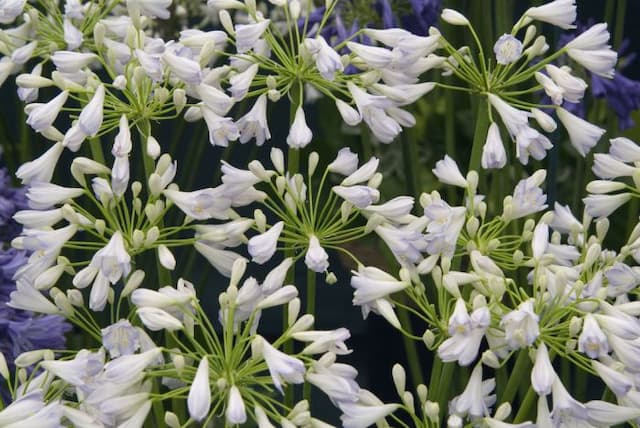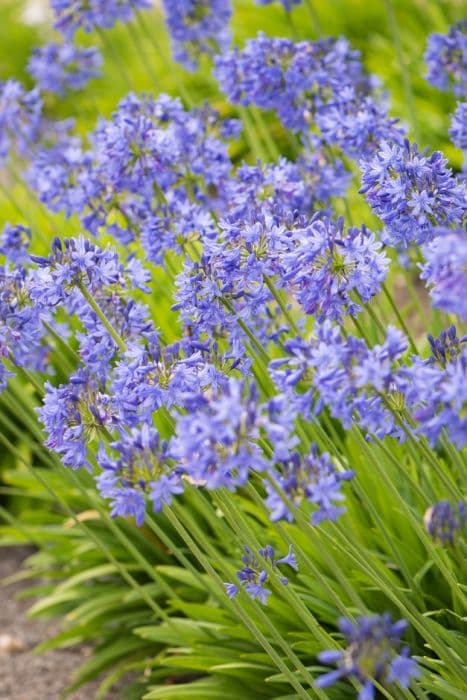African Lily Agapanthus caulescens

ABOUT
The plant commonly referred to as Agapanthus or African Lily boasts a lush clump of strap-shaped, green leaves that gracefully arch outward. These leaves provide a verdant backdrop for the plant's most striking feature: its blooms. The flowers appear in rounded clusters, called umbels, which are perched atop the long, slender stems that rise elegantly above the foliage. Each umbel is a spectacular burst of trumpet-shaped blossoms, typically in shades of blue or purple, though some varieties may also present flowers in white or pink hues. The delicate petals form a star-like pattern, converging to create a captivating display that adds a touch of exotic elegance to any setting. Indeed, the African Lily is renowned for its ability to infuse a sense of vibrant life and focus to gardens and landscapes with its bold floral presence.
About this plant
 Names
NamesFamily
Amaryllidaceae
Synonyms
African Lily, Lily of the Nile
Common names
Agapanthus caulescens.
 Toxicity
ToxicityTo humans
The plant commonly referred to as Agapanthus may be considered toxic if ingested. Although severe poisoning is rare, all parts of the plant especially the sap contain compounds that can cause symptoms such as nausea, vomiting, and diarrhea if consumed. In severe cases, and especially if large quantities are eaten, more serious symptoms such as abdominal pain or swelling of the throat could occur. Handling the plant without protection can sometimes lead to skin irritation or dermatitis.
To pets
The Agapanthus plant is also toxic to pets such as dogs and cats. Ingestion of any part of the plant can cause vomiting, diarrhea, drooling, lethargy, or other gastrointestinal issues. In extreme cases, it may lead to severe vomiting, weakness, and agitation. It's important to prevent pets from accessing or consuming this plant to avoid these potential health risks.
 Characteristics
CharacteristicsLife cycle
Perennials
Foliage type
Evergreen
Color of leaves
Green
Flower color
Blue
Height
2 feet (60 cm)
Spread
2 feet (60 cm)
Plant type
Bulb
Hardiness zones
9
Native area
South Africa
Benefits
 General Benefits
General Benefits- Landscape beautification: Adds aesthetic appeal to gardens with its striking blue flowers and lush foliage.
- Low maintenance: Requires minimal care once established, making it suitable for busy gardeners.
- Drought tolerance: Can survive with limited water, suitable for arid climates or water-wise landscapes.
- Attracts pollinators: Blossoms attract bees, butterflies, and other beneficial insects, promoting biodiversity.
- Erosion control: The root system can help stabilize slopes and prevent soil erosion.
 Medical Properties
Medical Properties- This plant is not used for medical purposes.
 Air-purifying Qualities
Air-purifying QualitiesThis plant is not specifically known for air purifying qualities.
 Other Uses
Other Uses- Agapanthus caulescens, commonly known as African lily, can be used in the production of blue dye. The deep blue color of its flowers provides a natural source for dyes in textile manufacturing.
- Its sturdy stems can be used in floral arrangements and provide a sculptural element to bouquets and decorations, lasting well as cut flowers.
- The fibrous roots of the African lily can be used in weaving or as a binding material in traditional crafts, due to their strength and flexibility.
- Agapanthus caulescens can be used in educational settings such as botanical gardens and schools to teach about plant biology and the diversity of flowering plant species.
- The flowers of the African lily can be used as a natural indicator for pH, as they may change color depending on soil acidity or alkalinity.
- It can be planted as part of a water-wise garden, often used in xeriscaping, to conserve water resources in dry climates due to its drought tolerance.
- The seeds of the African lily may be used in various artistic endeavors such as jewelry-making, where they can be dried and incorporated into beadwork or ornaments.
- African lily can play a role in permaculture gardens, contributing to the aesthetics and biodiversity without requiring excessive maintenance.
- The large clumps formed by mature African lily plants can be employed as a natural barrier or privacy screen in residential landscaping.
- It can be used as a companion plant in vegetable gardens to attract pollinators that are beneficial for plants such as tomatoes and peppers.
Interesting Facts
 Feng Shui
Feng ShuiThe African Lily is not used in Feng Shui practice.
 Zodiac Sign Compitability
Zodiac Sign CompitabilityThe African Lily is not used in astrology practice.
 Plant Symbolism
Plant Symbolism- Love Letters: The name "Agapanthus" is derived from the Greek words 'agape' meaning love, and 'anthos' meaning flower, which together symbolizes a love letter or a message of love.
- Beauty: With its striking blue to purple flowers, the Agapanthus is often associated with beauty and a picturesque appearance.
- Endurance and Survival: Given the plant's ability to thrive in harsh conditions and its vigorous growth habit, it has come to symbolize endurance and the ability to survive through adversity.
- Fertility: The abundant blossoms and the lush, green foliage are sometimes seen as a symbol of fertility and prosperity.
- Friendship: Because of its inviting and charming blooms, Agapanthus can also represent the beauty of friendship and the bonds between people.
 Water
WaterThe Agapanthus, commonly known as the Lily of the Nile, prefers consistent moisture but does not do well with soggy soil, so it's important to water it once the top inch of soil feels dry. This typically means watering about once a week, but the frequency may need to increase in hot, dry periods. When watering, do so deeply, providing enough water to reach the roots, which generally equates to about 1-2 gallons depending on the size of the plant and pot. During the winter months, reduce watering to every couple of weeks as growth is slower and the plant requires less moisture.
 Light
LightLily of the Nile thrives best in full sun to partial shade. Placing the plant in a spot where it receives at least six hours of sunlight per day will encourage optimal growth and blooming. However, in areas with extremely hot summers, providing afternoon shade will help protect the plant from intense, potentially damaging heat.
 Temperature
TemperatureLily of the Nile is hardy in zones where temperatures do not usually drop below 20 to 25 degrees Fahrenheit. While it can survive brief periods of cold, extended exposure to temperatures below this range can be harmful. Ideally, the plant prefers temperatures that stay consistently between 50 and 80 degrees Fahrenheit for thriving growth.
 Pruning
PruningTo maintain a tidy appearance and promote healthy growth, the Lily of the Nile should be pruned by removing spent flower stalks and any dead or damaged leaves. Pruning is best done in late fall or early spring. Additionally, every few years, it's beneficial to divide the clumps to prevent overcrowding and rejuvenate the plant. This also provides an opportunity to remove old, woody stems and refresh the soil around the plant.
 Cleaning
CleaningAs needed
 Soil
SoilAfrican Lily prefers well-draining soil with a loamy texture; a good mix would be two parts loam, one part perlite or sand, and one part compost. The ideal pH for African Lily is slightly acidic to neutral, ranging from 6.0 to 7.0.
 Repotting
RepottingAfrican Lily should be repotted every 2-3 years to prevent overcrowding and to refresh the soil. It's best to repot in spring before the growing season begins.
 Humidity & Misting
Humidity & MistingAfrican Lily thrives in average room humidity levels, but can benefit from higher humidity. Aiming for a range between 40-60% is ideal for healthy growth.
 Suitable locations
Suitable locationsIndoor
Place African Lily in bright, indirect light and away from drafts.
Outdoor
Grow African Lily in partial shade and shelter from strong winds.
Hardiness zone
7-10 USDA
 Life cycle
Life cycleThe life of Agapanthus caulescens, commonly known as the African Lily, begins with seed germination, which requires moist, well-drained soil and can take several weeks. Once germinated, the seedlings grow into young plants, forming strap-shaped leaves and establishing a root system. As it matures, the African Lily develops a thick, fleshy rhizome that stores nutrients and helps it survive periods of dormancy. During the flowering stage, which typically occurs in summer, tall stalks emerge bearing clusters of blue or white trumpet-shaped flowers, which can attract pollinators like bees and butterflies. After pollination, seed capsules form, eventually drying out and releasing seeds to start the next generation. As a perennial, Agapanthus caulescens will enter a phase of dormancy in the winter, with above-ground foliage dying back, to reemerge in the spring.
 Propogation
PropogationPropogation time
Spring to early summer
Propogation: The most popular method of propagation for Agapanthus caulescens, commonly known as the Lily of the Nile, is by division. This typically takes place in the late winter or early spring just before the growing season begins. To propagate by division, the clumps of the Lily of the Nile are carefully lifted from the ground, and the roots are gently separated with a sharp knife or spade. Each division should have at least one or two healthy shoots. These sections are then planted at the same depth they were growing at previously, spaced about 18 inches (approximately 45 centimeters) apart to allow sufficient room for growth. After planting, the divided clumps should be watered thoroughly to help establish them in their new locations.








![African lily [Brilliant Blue]](/_next/image?url=https%3A%2F%2Fplants-admin.emdemapps.com%2Fimages%2Fplants%2F%2Fimages%2F604b5e3c28e2b.png&w=640&q=75)
